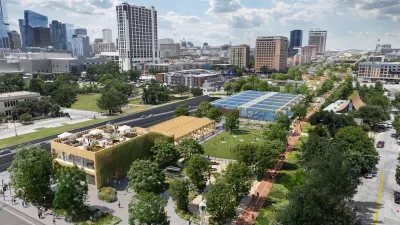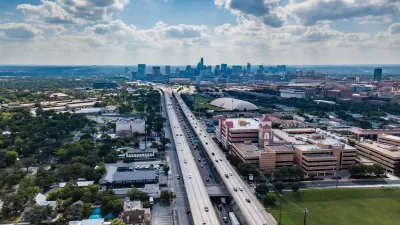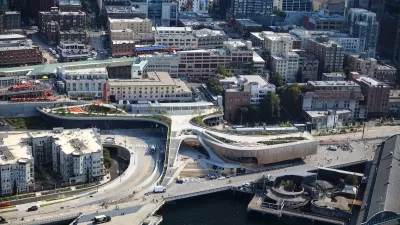The city’s plan includes parks, entertainment pavilions, commercial space, sports fields, and other facilities over 30 acres of deck parks spanning a sunken Interstate 35.

Newly revealed plans show Austin’s finalized vision for capping Interstate 35 after the Texas Department of Transportation lowers the main lanes below street level to accommodate deck parks.
Nathan Bernier describes the proposal, which includes a series of ‘caps and stitches,’ for KUT News. “Caps are more than 300 feet wide, and require advanced ventilation and fire suppression technology for the lanes below. Stitches are essentially caps that are less than 300 feet wide and don't require as much equipment.”
But don’t expect to walk around on top of I-35 anytime soon: “While the first cap could open as soon as 2032, a child born today would have graduated college by the time the plans depicted below are fully constructed,” Bernier notes. (See the source article for images.) Funding for the full project also remains unclear, although it has received some federal grants.
Bernier provides a walkthrough of the plans, outlining the key elements of each portion of the project. “Austin has to prove to TxDOT that it's serious about the capping project. The city must pay the state $19 million by the end of the year to finish engineering designs for the base caps. Local officials must also present TxDOT with a funding plan that shows how the city will pay for everything.”
FULL STORY: Austin reveals most detailed plans yet for parks over I-35

Planetizen Federal Action Tracker
A weekly monitor of how Trump’s orders and actions are impacting planners and planning in America.

San Francisco's School District Spent $105M To Build Affordable Housing for Teachers — And That's Just the Beginning
SFUSD joins a growing list of school districts using their land holdings to address housing affordability challenges faced by their own employees.

The Tiny, Adorable $7,000 Car Turning Japan Onto EVs
The single seat Mibot charges from a regular plug as quickly as an iPad, and is about half the price of an average EV.

Seattle's Plan for Adopting Driverless Cars
Equity, safety, accessibility and affordability are front of mind as the city prepares for robotaxis and other autonomous vehicles.

As Trump Phases Out FEMA, Is It Time to Flee the Floodplains?
With less federal funding available for disaster relief efforts, the need to relocate at-risk communities is more urgent than ever.

With Protected Lanes, 460% More People Commute by Bike
For those needing more ammo, more data proving what we already knew is here.
Urban Design for Planners 1: Software Tools
This six-course series explores essential urban design concepts using open source software and equips planners with the tools they need to participate fully in the urban design process.
Planning for Universal Design
Learn the tools for implementing Universal Design in planning regulations.
Smith Gee Studio
City of Charlotte
City of Camden Redevelopment Agency
City of Astoria
Transportation Research & Education Center (TREC) at Portland State University
US High Speed Rail Association
City of Camden Redevelopment Agency
Municipality of Princeton (NJ)





























